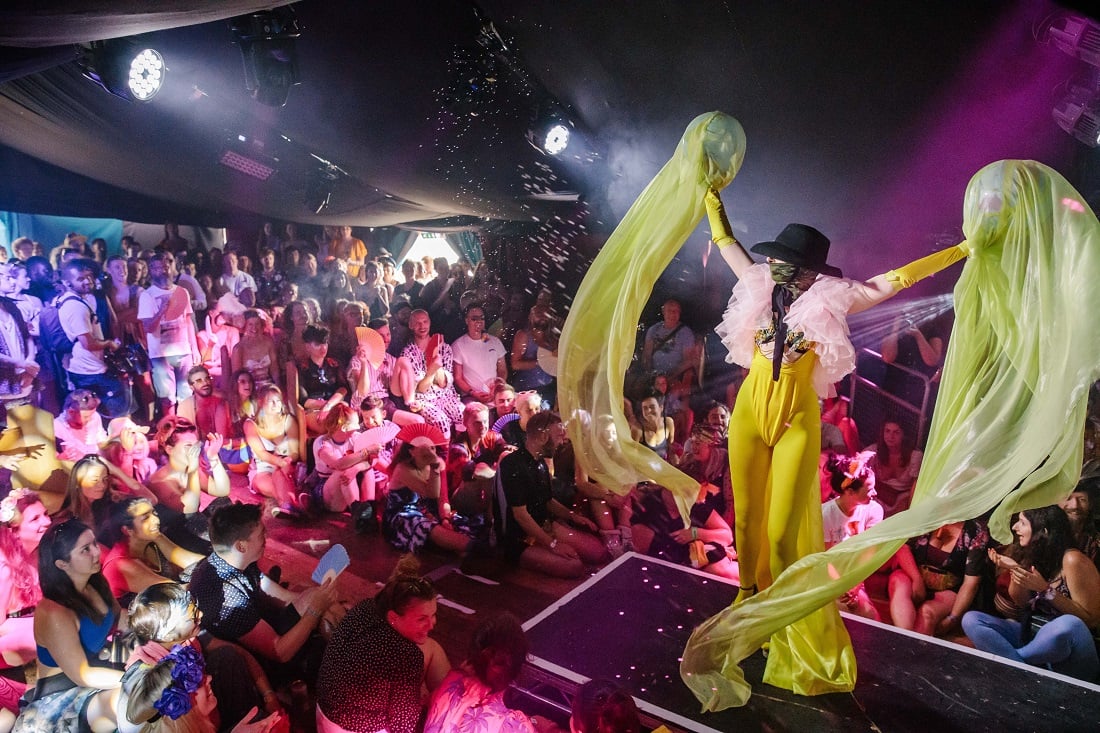
Wilderness Festival
Photo: © Andrew Whitton / Fanatic
New spaces, new places, new audiences
Taking indoor activity into outdoor spaces offers one possible solution to the challenge of social distancing. Kate Rolfe explores how it’s being done.
Let’s start with the obvious. With lower on-site capacity, reduced travel and ever-changing restrictions during the pandemic, it makes sense that at least some of the experiences arts organisations offer should move outside.
The alternative is the content simply moves online, so it’s accessible at home and offers a secure space with infinite options for delivery and engagement. Yet it’s clear that people are craving live, in-person activities where it’s safe to do so, and arts practitioners are eager to be reunited with their audiences. So cultural organisations around the world are finding many different ways of taking their indoor activities offsite.
Culture on the move
Netherlands-based Northern Light were commissioned by the National Museum of World Cultures to take museum objects usually kept in storage archives out to waiting rooms at train stations, creating ‘mini museums’ in collaboration with Dutch celebrities. Over 6 months they saw 25,000 visitors across five sites, engaging new audiences on their journeys to and from work as well as families at the weekend.
Culture on the high street
A unique cross-museum and cross-sector team is currently working to reimagine the role of museums in public life with a project nicknamed ‘P2P’ (Preservation to Presentation). P2P Programme Director Dave Thomas explains:
“This project is driven by two goals – to digitise museum content and create fair and open information-sharing models fit for a digital world, and to bring the life-improving benefits of the arts to people across the UK by interacting with them where they live.”
Through AR, VR and AV installations, the P2P public programme will bring culture to the UK high street, filling empty shops and socially-distanced streets with cultural content to enjoy as people shop. While an artistic and curatorial project is at its heart, it’s not lacking commercial appeal. Creative and customer-friendly channels are offered for everything from exhibition tickets and retail products to educational courses or sponsor offers.
Culture at a festival
The Wilderness Festival has long been providing a platform for arts organisations’ performances and workshops at their annual countryside event in Oxfordshire. The Charles Dickens Museum, the RSA, the Royal Geographical Society, Roundhouse, and the V&A have all been programming partners, and the Ashmolean went one further with a Wilderness take-over of its Live Friday event at the Museum. These collaborations allow organisations to integrate into a different part of their audiences’ spare time, and give cultural programmers cost effective pop-up opportunities. The same outcomes can be achieved online at virtual festivals.
Culture where you need it most
It’s not just about going outdoors. In New York and San Francisco you may come across MICRO, a fleet of 6ft tall museums that pop-up indoors in places like hospitals and airports, engaging children and adults at moments when they are waiting and might otherwise be bored or anxious. MICRO is also making strides to overcome inequality in cultural engagement, addressing the lack of museums in areas of cities that are predominantly home to ethnic minority communities, and overcoming the cost-barrier for those from lower socio-economic areas.
A hybrid solution?
For EverArt Weekend 2020, dance artist Julia Arsen worked simultaneously with Kuflex Lab on an online contemporary dance performance at GUM Red Line Gallery in Moscow, with the dancer and digital content interacting both live and virtually.
In this way artforms that are still restricted due to the pandemic can work with venues that have already re-opened, pooling audiences online. Ideally you go one further, broadcasting the live stream to those passing outside the venue, using either standard or interactive technology.
Is moving activities outdoors or offsite really worthwhile?
What going off-site achieves is audience growth, especially to groups who are historically under-served by the cultural sector due to distance, cost, available time, or generally feeling ‘the arts are not for me’. By taking activities to people where they live and work, adapting the content to tell the stories that are most relevant to them and delivering this via platforms that they usually engage with, you will start to see not only audience growth, but importantly, increased audience trust.
Trust builds reputation, reputation engages audiences and partners, and audiences and partnerships help you to be relevant and financially resilient.
When moving activities out of your building, make sure that audience reach and the depth of their engagement are monitored alongside any direct return you achieve through referral retail, membership, or exhibition income. To make a better return, consider how these activities might enhance a sponsorship deal, and what efficiencies might be found from overall marketing spend. These off-site activities do not need to be expensive, but if possible, consider ticketing them to offset the investment.
No matter the scale of the project, you should always work collaboratively to maximise the impact of any one external initiative, drawing on others’ collective expertise and networks to make it a truly consolidated undertaking.
Kate Rolfe is founder of The Revels Office a commercial and audience development consultancy that empowers arts organisations to generate new revenues and reach new audiences, connecting commercial clients with world-class content via place-making initiatives, and both live and digital brand campaigns.
![]() @therevelsoffice
@therevelsoffice
![]() @revels_office
@revels_office
Join the Discussion
You must be logged in to post a comment.